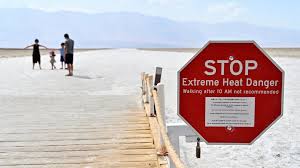Weather is a powerful force that shapes our environment and influences our daily lives. Around the globe, certain locations experience weather conditions that are extreme, awe-inspiring, and sometimes downright astonishing. From scorching deserts to freezing polar regions, these extreme weather locations offer a glimpse into the incredible diversity of Earth’s climate. In this article, we will explore some of the most extreme weather locations on Earth, uncovering fascinating facts about their climate, weather patterns, and the remarkable ways in which these environments impact life.
1. Death Valley, California: The Hottest Place on Earth

1.1. Record-Breaking Temperatures
- Historical Heat: Death Valley, located in California’s Mojave Desert, holds the record for the highest air temperature ever recorded on Earth. On July 10, 1913, Furnace Creek in Death Valley reached a staggering 134°F (56.7°C). This extreme heat is attributed to its low elevation and geographic location.
- Temperature Extremes: Death Valley experiences some of the most intense heat waves, with summer temperatures frequently exceeding 120°F (49°C). The combination of high temperatures and low humidity creates an incredibly arid environment.
1.2. Unique Environmental Conditions
- Lowest Point: The valley’s Badwater Basin, situated at 282 feet (86 meters) below sea level, is the lowest point in North America. The extreme heat in this area contributes to the formation of vast salt flats and unique geological formations.
- Adaptation to Heat: Despite the harsh conditions, various species have adapted to survive in Death Valley. For example, the desert bighorn sheep and the resilient creosote bush are well-suited to the extreme heat and dry conditions.
2. Antarctica: The Coldest Continent
2.1. Frigid Temperatures
- Record Cold: Antarctica is home to the coldest temperature ever recorded on Earth. On August 10, 2010, temperatures at the Soviet Union’s Vostok Station dropped to a bone-chilling -128.6°F (-89.2°C). The continent’s extreme cold is due to its high elevation and polar location.
- Polar Climate: The Antarctic climate is characterized by long, frigid winters and short, cool summers. The continent is covered by ice that reflects sunlight, contributing to its consistently low temperatures.
2.2. Unique Ice Formations
- Ice Sheets: Antarctica contains about 70% of the world’s fresh water in the form of ice. The Antarctic Ice Sheet is the largest single mass of ice on Earth, covering an area of approximately 5.4 million square miles (14 million square kilometers).
- Extreme Weather Patterns: The continent experiences unique weather patterns, including katabatic winds, which are strong, gravity-driven winds that flow down from the ice sheet, reaching speeds of over 200 mph (320 km/h).
3. Mount Everest: The Highest Point on Earth
3.1. Extreme Altitude
- Record Altitude: Mount Everest, the world’s highest peak at 29,032 feet (8,849 meters) above sea level, experiences extreme weather conditions due to its altitude. Temperatures at the summit can plummet to -76°F (-60°C) during winter, with wind chill factors making it even colder.
- Altitude Challenges: The thin air at high altitudes poses significant challenges for climbers. Oxygen levels are drastically reduced, and the risk of altitude sickness increases, making Everest one of the most challenging peaks to summit.
3.2. Severe Weather Conditions
- Storms and Winds: Everest is known for its severe weather conditions, including strong winds that can exceed 100 mph (160 km/h) and sudden storms. These weather patterns contribute to the mountain’s notorious difficulty and danger for climbers.
- Short Climbing Window: Due to its extreme weather, the climbing season on Everest is limited. The most favorable conditions occur during a brief window in May, when weather conditions are relatively stable.
4. Cherrapunji, India: The Wettest Place on Earth
4.1. Record Rainfall
- Heavy Rainfall: Cherrapunji, located in the Indian state of Meghalaya, is renowned for its record-breaking rainfall. The town receives an average annual rainfall of about 467 inches (11,871 mm), making it one of the wettest places on Earth.
- Monsoon Influence: Cherrapunji’s extreme rainfall is primarily due to its location on the windward side of the Khasi Hills. The monsoon winds from the Bay of Bengal bring heavy rains that are intensified by the region’s geography.
4.2. Unique Ecosystem
- Biodiversity: The extreme rainfall in Cherrapunji supports a lush and diverse ecosystem, including dense forests, unique flora, and abundant wildlife. The area is known for its living root bridges, which are created by growing tree roots across streams and rivers.
- Environmental Challenges: The heavy rainfall also poses challenges, including soil erosion and landslides. The local communities have developed innovative methods to manage and adapt to the region’s extreme weather.
5. Dubai, United Arab Emirates: The Hottest Urban Area
5.1. Extreme Heat
- Record Highs: Dubai, a major city in the United Arab Emirates, experiences extreme heat due to its desert climate. The city has recorded temperatures as high as 122°F (50°C) during summer months. The intense heat is compounded by high humidity levels.
- Urban Heat Island Effect: Dubai’s rapid urbanization and development contribute to the urban heat island effect, where built-up areas experience higher temperatures compared to surrounding rural areas.
5.2. Adaptation Strategies
- Cooling Technologies: Dubai has implemented various cooling technologies to manage the extreme heat, including air-conditioned bus shelters and cooling systems for outdoor areas. The city’s architecture incorporates innovative designs to reduce heat absorption.
- Green Initiatives: To combat the heat and improve air quality, Dubai is investing in green spaces and sustainable practices. The city’s green initiatives include urban parks, green roofs, and renewable energy projects.
6. Barrow (Utqiaġvik), Alaska: The Northernmost City

6.1. Polar Climate
- Extreme Cold: Utqiaġvik (formerly known as Barrow) is the northernmost city in the United States, located above the Arctic Circle. The city experiences long, harsh winters with temperatures often dropping below -20°F (-29°C). The extreme cold is exacerbated by the polar climate.
- Polar Night and Midnight Sun: Utqiaġvik experiences unique polar phenomena, including the Polar Night, where the sun does not rise above the horizon for several weeks during winter, and the Midnight Sun, where the sun does not set for several weeks during summer.
6.2. Cultural Adaptations
- Indigenous Practices: The local Iñupiat people have adapted to the extreme cold with traditional practices and clothing, including insulated parkas and fur-lined boots. These adaptations are essential for surviving the harsh Arctic conditions.
- Community Resilience: Despite the challenges of living in such an extreme environment, the community has developed a strong cultural and social fabric that thrives in the face of severe weather conditions.
7. Conclusion
Earth’s most extreme weather locations offer a fascinating glimpse into the planet’s diverse climates and the remarkable ways in which life adapts to these conditions. From the scorching heat of Death Valley to the freezing cold of Antarctica, these locations showcase the incredible range of weather phenomena that shape our world. By exploring these extreme environments, we gain a deeper appreciation for the power of weather and the resilience of the life that endures in the most challenging conditions.

